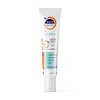What's inside
What's inside
 Key Ingredients
Key Ingredients

 Benefits
Benefits

No benefits
 Concerns
Concerns

 Ingredients Side-by-side
Ingredients Side-by-side

Petrolatum
EmollientButyl Methoxydibenzoylmethane
UV AbsorberEthylhexyl Methoxycinnamate
UV AbsorberEthylhexyl Salicylate
UV AbsorberOctocrylene
UV AbsorberBenzophenone-3
UV AbsorberC18-38 Alkyl Hydroxystearoyl Stearate
EmollientOctyldodecanol
EmollientGlycerin
HumectantRicinus Communis Seed Oil
MaskingCaprylic/Capric Triglyceride
MaskingPanthenol
Skin ConditioningWater
Skin ConditioningPolyglyceryl-3 Diisostearate
EmulsifyingButyrospermum Parkii Butter
Skin ConditioningTocopheryl Acetate
AntioxidantHydrogenated Castor Oil
EmollientBeeswax
Emulsion StabilisingC20-40 Alkyl Stearate
Skin ConditioningMagnesium Sulfate
Magnesium Stearate
Cosmetic ColorantBHT
AntioxidantPetrolatum, Butyl Methoxydibenzoylmethane, Ethylhexyl Methoxycinnamate, Ethylhexyl Salicylate, Octocrylene, Benzophenone-3, C18-38 Alkyl Hydroxystearoyl Stearate, Octyldodecanol, Glycerin, Ricinus Communis Seed Oil, Caprylic/Capric Triglyceride, Panthenol, Water, Polyglyceryl-3 Diisostearate, Butyrospermum Parkii Butter, Tocopheryl Acetate, Hydrogenated Castor Oil, Beeswax, C20-40 Alkyl Stearate, Magnesium Sulfate, Magnesium Stearate, BHT
 Reviews
Reviews

Ingredients Explained
These ingredients are found in both products.
Ingredients higher up in an ingredient list are typically present in a larger amount.
You probably know this ingredient as Oxybenzone, a sunscreen ingredient. It is a broad-spectrum sunscreen ingredient, meaning it can protect the skin against UVB and short UVA rays. The absorption range is 270-350 nm with peak absorption at 288 and 350 nm.
This chemical ingredient protects your skin by using chemical reactions to convert UV rays into heat and energy. UV absorbers may absorb both UVA and UVB rays. It is often combined with other sunscreen ingredients to help with stability.
Ongoing research is looking into whether oxybenzone causes skin irritation and sensitivity. However, it has been shown to trigger contact dermatitis in some studies.
Oxybenzone is allowed in certain concentrations by many countries. It is allowed up to 6% in the US, and Canada, 5% in Japan, and 10% in Australia. Other countries and regions of the US have banned this ingredient to protect coral reefs and marine ecosystems. These places include Hawaii, Key West, US Virgin Islands, marine parks in Thailand, Aruba, and Palau.
The EU currently allows the following maximum concentrations:
Studies show conflicting results about oxybenzone being absorbed into the human body. The Swedish Research Institute has advised careful use of this ingredient by pregnant women and children. We always recommend speaking with a professional if you have concerns about this ingredient and your health.
Learn more about Benzophenone-3Also known as Avobenzone, this ingredient is a chemical sunscreen filter that provides protection in the UV-A range.
Avobenzone is globally approved and is the most commonly used UV-A filter in the world.
Studies have found that avobenzone becomes ineffective when exposed to UV light (it is not photostable; meaning that it breaks down in sunlight). Because of this, formulations that include avobenzone will usually contain stabilizers such as octocrylene.
However, some modern formulations (looking at you, EU!) are able to stabilize avobenzone by coating the molecules.
Avobenzone does not protect against the UV-B range, so it's important to check that the sunscreen you're using contains other UV filters that do!
The highest concentration of avobenzone permitted is 3% in the US, and 5% in the EU.
Learn more about Butyl MethoxydibenzoylmethaneEthylhexyl Methoxycinnamate is an organic compound that provides UVB protection. It often goes by the more common name of octinoxate. It is created from methoxycinnamic acid and 2-ethylhexanol.
Ethylhexyl Methoxycinnamate absorbs UVB rays with wavelengths between 280-320 nm. UV absorbers protect your skin by using chemical reactions to convert UV rays into heat and energy.
UVB (290-320 nm) rays emit more energy than UVA rays. They are capable of damaging DNA, causing sunburns and are thought to be linked to skin cancer.
The state of Hawaii has banned sunscreens containing octinoxate due to its potential impact on coral reefs. More research is needed to bridge gaps in this research. The European Union allows higher levels of octinoxate in sunscreens than the US and Australia.
Ethylhexyl Methoxycinnamate is oil soluble. It is not stable and may lose efficacy when exposed to sunlight.
Learn more about Ethylhexyl Methoxycinnamate